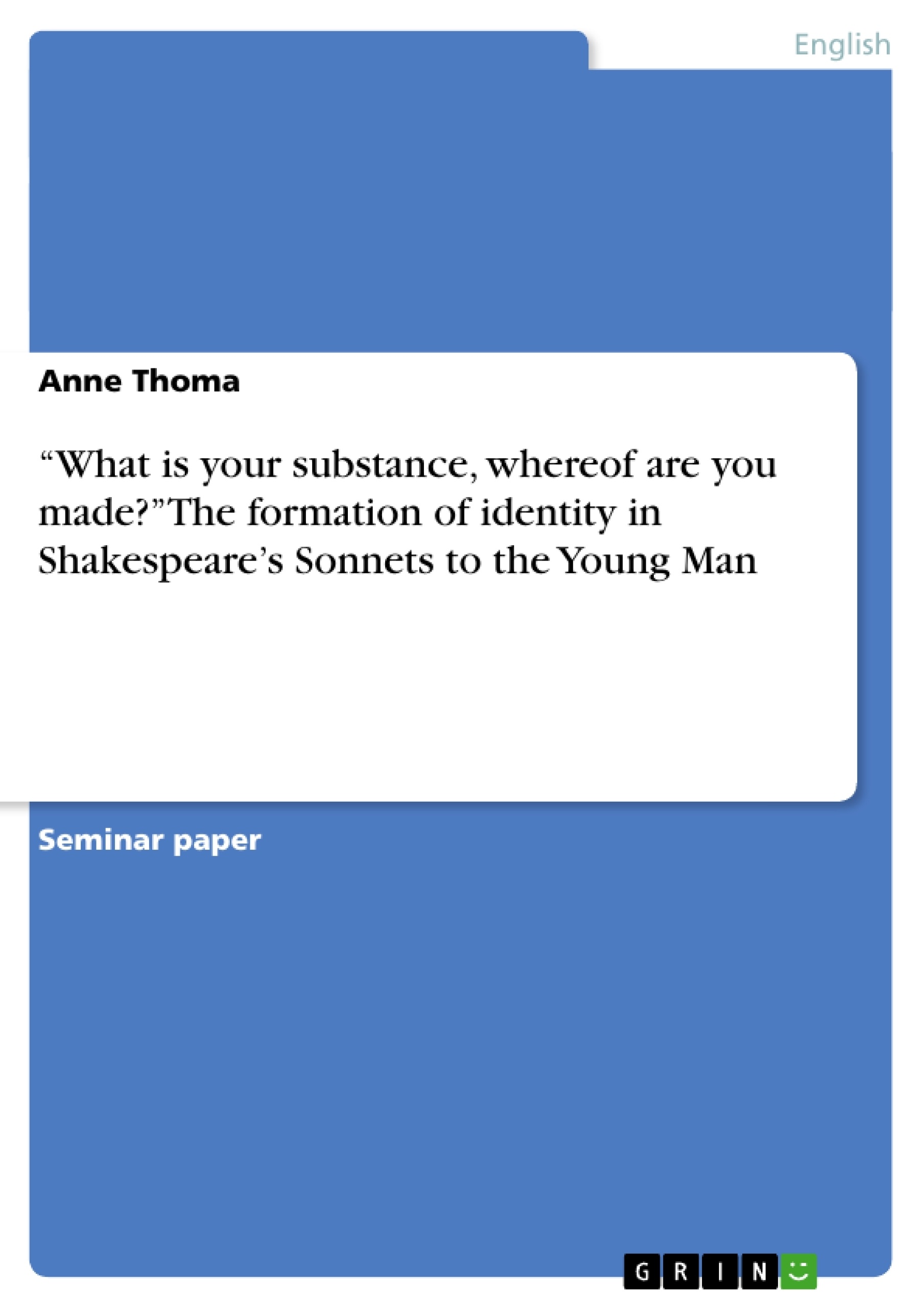Shakespeare’s sonnets have often been discussed in terms of the degree of their
autobiographical content. The question what role the persons which the poet addresses, a
young man and a dark woman, had actually played in the author’s life sparked as much debate
as the opaque initials “W. H.”, a dedication by Thomas Thorpe, who had published a Quarto
by the title of ‘Shakespeare’s Sonnets. Never before imprinted’ in 1609 (Edmondson / Wells
4). Some critics were led to conclude their research with triumphant statements such as
‘Shakespeare’s Sonnets. The Problems solved’, a title employed by A. L. Rowse in 1964.
Rowse claims to have spotted the identity of the young man, the dark lady, the rival poet, as
well as of “W. H.”. His edition of the sonnets also includes a chapter called “The Story: its
Outlines” (24).
Other critics have been focussing less on a coherent story with identifiable characters. In their
analysis, they often take a purely immanent stance and are more concerned with how the poet,
the speaking voice of the sonnets, establishes an identity, a private subjectivity and sensibility
and in the course of his amorous encounters engages in a struggle to keep them afloat. I want
to argue along the lines of those researchers who put the previously rather central issues of
homosocial desire and Platonic and Petrarchan love into the lager context of what Stephen
Greenblatt calls the “self-fashioning” of the Renaissance individual (1). He points out that
“the power to impose a shape” upon oneself or another person is a major issue in the English
Renaissance, the age of “the formation of identity” (1 / 6). According to Colin Morris, there
had been distinctions between “types and individual representation” as early as 1020 (33 /
65), but A. J. Piesse states that “self-interrogation” beyond a religious context began to loom
only at the beginning of the sixteenth century (634). In the 80s, Stephen Greenblatt and
Catherine Belsey stressed that “any formulation of identity must be seen in the light of
cultural context, that any exposition of self is a manifestation of a series of options, rather
than something intrinsically different from anything else” (Piesse 635). In his work Sources of
the Self of 1989, Charles Taylor differentiates along the lines of Plato and Aristotle between
the importance of context and interior self for the individual (Ibid 635).
Inhaltsverzeichnis (Table of Contents)
- Introduction
- "What is your substance, whereof are you made?" - The Formation of Identity in Shakespeare's Sonnets to the Young Man
- Emotional and sexual identity
- The relationship of the poet and the young man in the light of Renaissance concepts of sexuality
- Fashioning the young man: Towards an androgynous ideal
- The philosophical formation of identity via Neo-Platonism
- Art as a source of identity
- Nature: Modelling body and will
- Identity rooted in poetry
- The sublimated young man
- Epideictic praise and narcissism
- Conclusion
Zielsetzung und Themenschwerpunkte (Objectives and Key Themes)
This essay aims to explore the formation of identity in Shakespeare's sonnets to the young man, specifically analyzing how the poet and his friend construct their identities within the context of Renaissance culture and the relationship between them. The essay focuses on identifying and examining the resources that shape their identities and how these resources are used to create a sense of self.
- Renaissance concepts of sexuality and their influence on the portrayal of the poet-friend relationship.
- The role of the androgynous ideal in fashioning the young man's identity.
- The influence of Neo-Platonic philosophy on the formation of identity through the relationship.
- The significance of art, particularly poetry and nature, as sources of identity.
- The exploration of narcissistic tendencies and their impact on the poet's self-perception.
Zusammenfassung der Kapitel (Chapter Summaries)
The first chapter delves into the complexities of emotional and sexual identity in the sonnets, examining the relationship between the poet and the young man through the lens of Renaissance notions of sexuality and sodomy. It analyzes the possible homoerotic undertones present in the sonnets and explores how the poet's relationship with the young man is portrayed within the social context of the time.
The second chapter shifts focus to the philosophical underpinnings of identity formation, specifically exploring the influence of Neo-Platonism on the poet-friend relationship. It draws on Plato's theories of love as presented in his works Symposium and Phaedrus to illuminate the philosophical dimensions of their connection.
The third chapter examines the role of art in shaping identity, focusing on the influence of nature and the concept of sublimation on the young man's self-perception. It explores how the poet uses artistic techniques to create a refined and idealized image of his friend.
Schlüsselwörter (Keywords)
This essay focuses on the keywords: Renaissance sexuality, identity formation, homosocial desire, Neo-Platonism, art, sublimation, narcissism, and Shakespeare's sonnets to the young man.
- Citation du texte
- Anne Thoma (Auteur), 2006, “What is your substance, whereof are you made?” The formation of identity in Shakespeare’s Sonnets to the Young Man, Munich, GRIN Verlag, https://www.grin.com/document/83235



